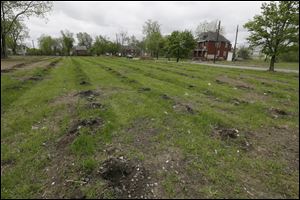
Project bringing 15K trees to distressed Detroit
5/16/2014
Vacant land in east Detroit is seen. A mass tree-planting effort is planned for Saturday as part of a large-scale project by a company that wants to put vacant Detroit land to agricultural use.
DETROIT — The holes — 15,000 of them — have been dug in the two fields that once cradled homes and families in Detroit but now make up one of the most distressed neighborhoods in the bankrupt city.
On Saturday, those holes will be filled with maple and oak saplings.
John Hantz hopes the two nearly block-long fields will one day be a mini-forest in the middle of the city. The 53-year-old entrepreneur believes agriculture and forestry can refill Detroit’s abandoned acres.
“Let the trees grow. Let them beautify,” he said.
His Hantz Woodlands project on the east side was approved last year by Detroit’s state-appointed emergency manager and also calls for the cleanup of 140 acres of land and the razing of 50 vacant houses. It aims to improve the face of the city and attract new residents and is separate from city-planned large-scale demolitions and other blight-eradication efforts.
Detroit has about 700,000 residents. Over the past two decades, more than a quarter-million people have moved from the 139-square-mile city. A recently completed survey is expected to reveal just how many houses and buildings sit vacant, though estimates a few years ago put the number well above 30,000.
“I’ve lived here 20 years, and I’ve spent a lot of those years waiting for someone to do something,” Hantz told The Associated Press on Thursday at the tree-planting site. “It dawned on me: I’m going to quit complaining about it like everybody else and go try to do something.”
Hantz, founder and chief executive of the Hantz Group, a network of financial services businesses, estimates that he’s spent more than $1 million so far acquiring the land from the city, clearing it and disposing of everything from gas tanks to “hundreds upon hundreds” of dumped tires to even a boat.
The saplings cost about $20,000.
“We have to get people to stay. Once they stay then we can begin to add development ...” he said
As former City Council president and mayor, and now head of an ambitious 50-year plan to reshape the Motor City, Ken Cockrel Jr. has worried about what to do with Detroit’s estimated 20 square miles of vacant, abandoned and underused land.
“That’s equal to the size of Manhattan,” said Cockrel, executive director of the Detroit Future City implementation office.
Hantz Woodlands is consistent with recommendations in the Detroit Future City plan, which also looks at job creation, green space, transportation, growth and investment opportunities.
“It is an opportunity to take a lot of this vacant property that was a liability and turn it into an asset,” Cockrel said.
Once planted, the rows of saplings will be across the street from Ray Anderson’s home. The 57-year-old city of Detroit retiree said he will join 1,200 other volunteers to help with the planting. So will his family and members of his church.
His house is one of only a few left on his block.
“It’s been a blessing,” Anderson said of the woodlands project. “This was an ugly neighborhood, an ugly place. Now you can look outside and look toward the future.”